| Nikola Tesla | Theory | Basics | Measurements | The Tesla Magnifier | Magnifier project | Links | Homepage |

|
My first Tesla Coil |
Last update |
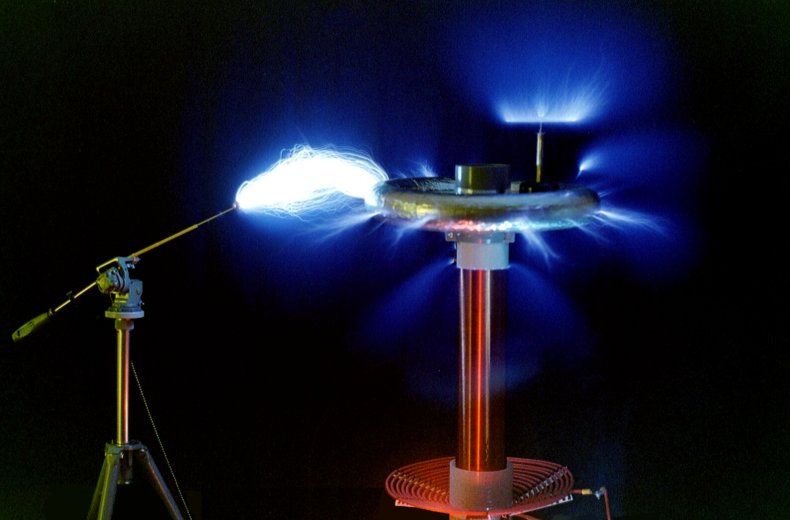
|
PRIMARY Inverted conical, angle ~ 20° 12 turns, tap on 8 and 10 Wire section 6 mm² (7 threads Ø 1 mm, insulated) Wire lenght 7.76 m Øint = 100 mm Øext = 300 mm Lp = 31 µH Rp = 22 mohms (milli-ohms) Q (@400 kHz,calculated) = 3500 |
SECONDARY PVC pipe Ø = 8 cm 855 turns, tight wound Wire Ø = 0.4 mm Wire lenght = 215 m Lenght of coiling = 38 cm Ls = 11.6 mH Rs = 29.8 ohms Q (@400 kHz,calculated) = 960 |
CAPS 2 ceramic HV capacitors in parallel each 3 nF, 20 kV RMS TOROID Øext = 355 mm Øsection = 55 mm Thermal insulating foam covered with adhesive aluminium tape |
|
SPARK GAP Static multi gap 11 coper pipe sections Ø = 12 mm, l = 40 mm Gap lenght = 0.8 mm Only 5 gaps used, others shorted |
POWER SUPPLY Neon sign transformer 16 kV / 30 mA VARIAC 0 - 237 V @ 3 A |
PROTECTION 2 air core choke inductances, each 3.5 mH, multi lumped winding (strike rail not yet installed) |
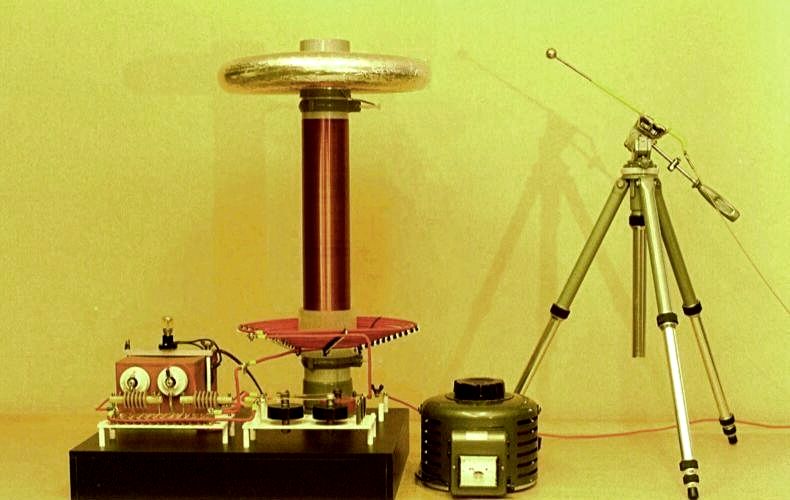
Results and experimentation
October, 2000The pipe sections of my spark gap where first holded in place by polyamide links on an epoxy-fiberglass substrate. I get 25 cm arcs, but relatively thin and not very impressive. The polyamide links became quickly coal-black. I then perfected my SG, I suppressed the links and mounted the pipes with a two components epoxy glue. The result was great, the arcs bright and very impressive... for a fraction of a second only! Then the caps defuncted.
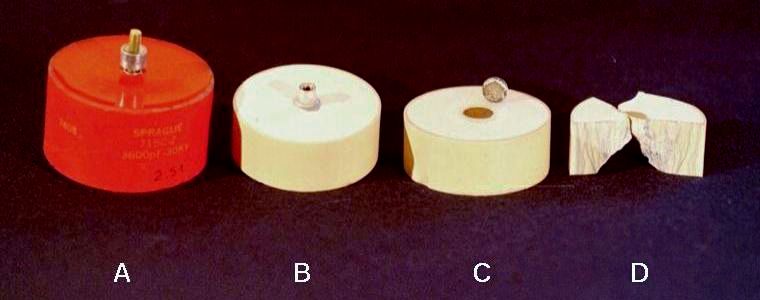
- An old ceramic capacitor (year 1974) molded with epoxy, I got it at the Hamexpo flea market.
- The same cap with epoxy removed (it was moderately hard) shows the baryum titanate disc and a connecting terminal.
- Excess of current : the soft soldering of the terminal on the metallized face of the disk has failed.
- Excess of voltage or too great a rise time : the disk has breaked, tracks of arcing are visible on the surface of the crack.
I am now coming to explore three ways for caps :
- to acquire oil filed caps and connect them in serial configuration
- to build caps with 2 mm thick polyethylene and aluminium foil (perhaps oil filled)
- to build salt water bottles, some measurements on a prototype show that a 70 cl whisky
bottle give a capacitance of 0.82 nF. I have still to drink 7 bottles to get 6 nF !
December 5, 2000
My bottle capacitor is now completed : 8 bottles of 0.82 nF each = 6.56 nF.
A short run provided the following results
- streamers about 25 cm in lenght, very pale, hardly visible in daylight
- no bright blue-white discharges
- many luminous streamers on the upper and lower parts of the bottles not covered with aluminium
- large production of ozone (characteristic odor). Is it a way to fill up the ozone hole ?
I am moderately disappointed. The bottle-capacitor seams to be a crappy thing.
Perhaps I have to try another brand of whisky ?

December 6, 2000
My polyethylene capacitor assembly is up, althought not yet caned with oil. The structure is a crossed zig-zag of aluminium foil 30 micro meters thick (food packing type) onto 2 mm thick polyethylene as dielectric, in all, 33 layers, C = 6.76 nF . The tests at reduced power showed bright sparks but where stopped because the capacitor arced on the edges of the stacking (27 mm from plate to plate). This type of capacitor seams very promising, I have only to can it with oil before carrying new tests.

I finally dipped my polyethylene capacitor into motor oil. The provisional container is a small plastic trash can. I used some expanded polystyrene blocks to minimize the oil quantity.
The results are as good as expected. I get now very bright lightning-like discharges about 25 cm long (10") and very few corona. My SSG is optimaly adjusted to 3.2 mm (4 x 0.8 mm) by shorting the unused sections.
See the sparks at the top of this page.
January 17, 2001
These last days I made two new devices :
1 - A new protection circuit (not yet installed) using 2 toroidal cores (36/23/15mm, Al=
3700 nH/sp2) onto wich I coiled 40 turns of 1.5 mm2 of insulated installation wire. The inductance is 6 mH.
I added to them an adjustable protection gap.
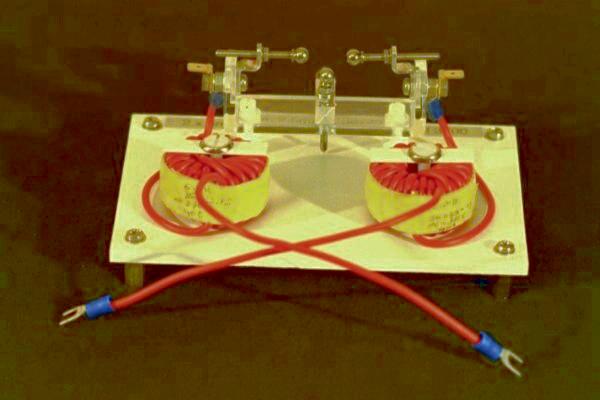
2 - A new static spark gap (not yet installed). From an idea borrowed from Kip Turner, it uses a piece of printed circuit board as substrate and 8 copper pipes 20 mm diameter by 50 mm lenght. It is quasi linearly adjustable from 2.1 to 5.6 mm by simple flexion. There is 7 gaps and without any positive or negative flexion each elementary gap is 0.6 mm wide.
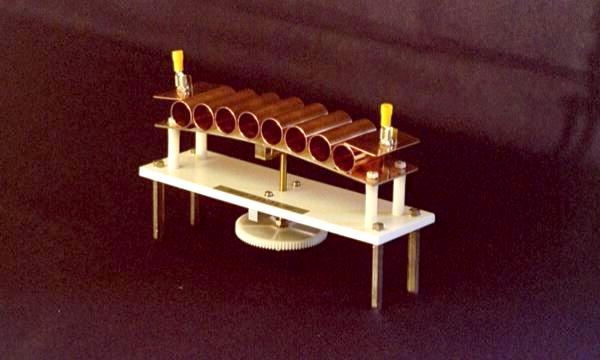
January 20, 2001
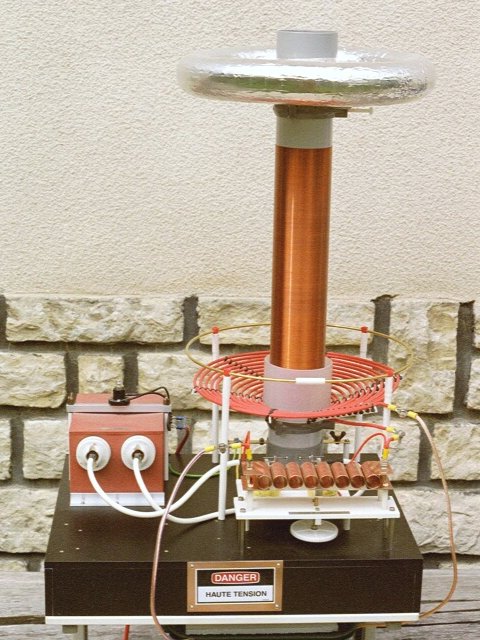
I installed the new protection circuit and the new adjustable SSG. The toroidal ferrite chokes are better
than the former honeycomb ones as they have a low Q and attenuate parasitic surges. The tri-pole protection
gap was adjusted to 6.5 mm versus ground and 13 mm between transformer terminals. No sparks where yet seen
there. I also installed a strike rail about 4 cm above the primary. It is made of 4 mm dia. brass pipe bended
onto a 32 cm form and supported by 4 PVC spacers. As expected, no visible changes when runnning.
On the left, my first TC with adjustable spark gap and strike rail, the poly cap is under the table.
June 16, 2001
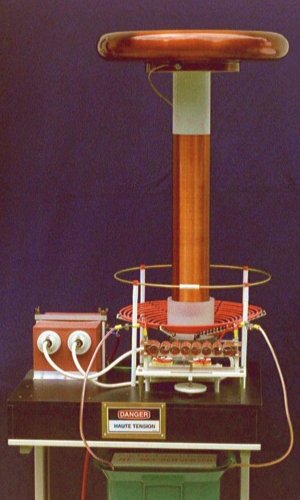
I replaced the home-made toroid by an aluminium pseudo-toroidal piece, 40.5 cm in diameter and 6 cm hight, borrowed from an old houselight. Its shape and size are appropriate but it has the top side open on a diameter of 35.5 cm and it is varnished. This seams not to be a problem and the running results are not changed. It is aesthetically more pleasant. On the right my first TC with the varnished !... aluminium pseudo-toroid, the poly cap is under the table.

Do not experiment with Tesla Coils if you do not understand well what you are doing. Any error may be fatal and the right to do it again is rarely granted. So your first mistake may be the last.
|
|
Nikola Tesla | Theory | Basics | Measurements | The Tesla Magnifier | Magnifier project | Links | Homepage |
File: my_first.html - Robert L.E. Billon, 2000-10-30 - Last update: 2010-11-05